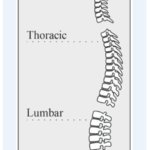
(February 5, 2013): A "back orthosis" is type of brace that is placed on the outside of a patient’s body and is intended to help stabilize a patient’s spine. In some instances, it is used to limit motion. In others, it is used to address a structural deformity which may exist (such as scoliosis). There are three primary uses of this type of brace. It is typically utilized to: (a) Provide back support; (b) Reduce back pain' and (c) Facilitate the healing of a patient’s spine. As discussed below, the ordering of a back orthosis is usually done by a qualified treating physician. In most cases, the brace is then "fitted" by a qualified DME supplier and billed to Medicare, Medicaid or another responsible payor. Claims for orthotic devices of this type billed to Medicare under HCFA’S Common Procedure Coding System (HCPCS) code L0631. The description for this type of device includes the following:
"Lumbar-sacral orthosis, sagittal control, with rigid anterior and posterior panels, posterior panels, posterior extends from sacrococcygeal junction to a T-9 vertebra, produces intracavitary pressure to reduce load on the intervertebral discs, includes straps, closures, may include padding, shoulder straps, pendulous abdomen straps, pendulous abdomen design, prefabricated, includes fitting and adjustment."
I. Overview of the DME Back Brace Reimbusement Environment
As one would imagine, there are a wide variety of orthotics for the back being sold by DME suppliers at any one time. While many braces of these products are custom-fitted, some are little more than general-use orthotic products for the back which do not require individualization.
- Basic Coverage Requirements. In order to qualify for coverage by Medicare, an orthosis used on the back must be prescribed for one of the following indications:
- To reduce pain by restricting mobility of the trunk;
- To facilitate healing following an injury to the spine or related soft tissue;
- To facilitate healing following a surgical procedure on the spine or related soft tissue, or
- To otherwise support weak spinal muscles and/or a deformed spine. [1]
- Medicare Billing Requirements. In order to bill Medicare, a DME supplier must have a written order from a physician indicating that the device is reasonable and necessary for the patient. Most Medicare patients obtain their brace from a DME supplier. DME suppliers obtain their stock from manufacturers and wholesalers of the device.
- Audits of DME Claims Resulted in a Number of Concerns Being Identified by the OIG. In recent years, the cost of these products to the Medicare program has greatly increased. A number of concerns with this device have been identified by the Department of Health and Human Services, Office of Inspector General (OIG). As the OIG noted in its recent report titled: "Medicare Supplier Acquisition Costs for L0631 Back Orthoses," OEI-03-11-00600 (December 2012), these concerns include:
Cost to the Medicare program. In its December 2012 report, the OIG stated that "[f]rom 2008 to 2011, Medicare claims for L0631 back orthoses more than doubled, increasing Medicare allowances from $36 million to more than $96 million".
The acquisition cost to DME suppliers is far lower than Medicare’s allowable reimbursement for this type of device. As HHS-OIG noted The OIG also found that the Medicare-allowed amount paid to DME suppliers for an L0631 was $919, despite the fact that the average supplier acquisition cost was only $191.
Many DME supplier have failed to fit and adjust the devices. While the definition of L0631 clearly includes "fitting and adjustment" approximately one-third of the DME suppliers billing Medicare for these types of braces did not report that they had provided fitting and adjustment services.
Practically all DME suppliers only provided "general instruction" to patients on their use of back orthoses. As OIG’s report reflects, approximately 93 percent of all DME suppliers did not provide any additional services regarding the use of the L0631 brace.
- Results of a Widespread Prepayment Probe. Noridian Administrative Services, Inc. (Noridian) is a Durable Medical Equipment, Medicare Administrative Contractor (DME MAC), and is responsible for handling claims in Jurisdiction D. In mid-December 2012, Noridian posted its findings associated with a recent "Widespread Prepayment Probe Review of Spinal Orthoses (HCPCS L0631 and L0637)". As the contractor noted, out of 101 claims for L0631, 96 were denied after being reviewed and assessed. The primary reasons for denial were lack of medical necessity, lack of supporting documentation and lack of proof of delivery. Similar deficiencies were noted in their analysis of L0627.
II. Possible Future DME Claims Audits of Back Braces:
Based on their probe audit findings, Noridian has announced that it will now be initiating a "widespread targeted review on HCPCS codes L0631 and L0637". While administrative review of these claims is imminent, it is important to keep in mind that HHS-OIG will likely continue its assessment of these specialized claims. As a participating DME supplier, you are obligated to fully comply with all of the applicable rules and regulations governing the medical necessity, coverage, documentation, billing and coding of these back orthoses. When is the last time you have compared your practices with the requirements set out in your applicable Local Coverage Determination (LCD) guidance?
III. Final Remarks:
DME suppliers have been under the proverbial "microscope" for some time now. The recent deficiencies noted by both the OIG and Noridian will likely further intensify the oversight imposed on DME suppliers. Now, more than ever, it is essential that you develop and implement an effective Compliance Program which addresses these and other DME supplier risk areas. If you are audited by a Zone Program Integrity Contractor (ZPIC), your DME company may be facing a myriad of administrative sanctions if your practices do not fully conform with the rules. ZPIC administrative enforcement actions have included:
- Seeking permission from the Centers for Medicare and Medicaid Services (CMS) to suspend a DME supplier.
- Seeking permission from CMS to revoke a DME supplier’s Medicare number.
- Placing a DME supplier on prepayment review.
- Initiating a post-payment ZPIC audit of prior paid DME claims.
Should a ZPIC believe that a DME supplier’s conduct is best addressed at a higher level, the contractor may refer its concerns to the OIG or the Department of Justice so that law enforcement can initiate an investigation of the supplier.

Robert W. Liles and other Liles Parker attorneys have extensive experience representing DME suppliers in ZPIC audits of all types. Should you have any questions, please call Robert for a free consultation. He can be reached at: 1 (800) 475-1906.
- [1] Local Coverage Determination (LCD) for Spinal Orthoses: TLSO and LSO (L11470), January 1, 2010. This is the LCD for one of the four claims processors for durable medical equipment, prosthetics, orthotics, and supplies (DMEPOS). The other three claims processors have identical LCDs. LCD L11470 was accessed at http://www.medicarenhic.com/dme/medical_review/mr_lcds/mr_lcd_current/L11470_2010-01-01_PA_2010-07.pdf on October 5, 2011.
